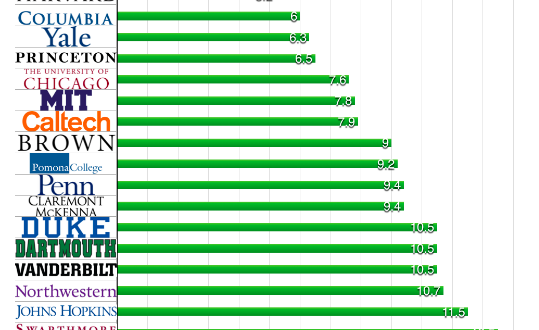By Aimi Wen
For anyone even remotely aware of the college process, he or she would know that college rankings play a huge role. Want to study chemical engineering? Look up the rankings for the schools that have the top programs. Want to find out which college offers the best education? Look up the rankings of the schools. However, the importance of college rankings is not only imprinted into students but also the colleges themselves. Because college rankings affect the pool of applicants–such as how qualified they are and how many apply–colleges tend to angle whatever they do in order to boost rankings. Factors in rankings include acceptance rate, yield rate, standardized test scores, retention rate, and alumni giving. Unfortunately, rankings do not reveal how a college might go about boosting the aforementioned rankings, leading to a hidden consequence: reinforcing economic inequality. According to the Equality of Opportunity Project, there are more students from the top 1 percent of earners than from the bottom 60 percent combined at top schools, such as the Ivy League (Wermund).
Why is this happening? As mentioned before, the “how” of raising rankings are hardly ever looked at and this important “how” is causing harm. For example, to obtain high standardized test scores, colleges would then, of course, accept students who have high test scores. However, the students with high test scores are hardly ever from a lower economic class; they tend to be of higher classes, able to afford the cost of tutors and expensive education. Another example is alumni donation. To keep their alumni happy to attract donations and to boost their rankings, colleges would be inclined to accept the children of the alumni–most of whom are from the top 1 percent. Since retention rates are also important, schools tend to not accept lower income students. To lower the acceptance rate and increase yield rate, schools, like from the Ivy League, heavily depend on early decisions, hurting lower income students who need to compare financial aid packages of different schools (Aisch, Buchanan, Cox and Quealy).
College rankings, however helpful they may be, are perpetuating a cycle of economic inequality. Lower income students can perform well in college–repeated studies have shown that their performances are not inferior to those of higher-income. They just need to be given a chance to prove themselves.
Works Cited:
Aisch, Gregor, et al. “Some Colleges Have More Students From the Top 1 Percent Than the
Bottom 60. Find Yours.” The New York Times, The New York Times, 18 Jan. 2017, www.nytimes.com/interactive/2017/01/18/upshot/some-colleges-have-more-students-from-the-top-1-percent-than-the-bottom-60.html.
Wermund, Benjamin. “How U.S. News College Rankings Promote Economic Inequality on
Campus.” POLITICO, 10 Sept. 2017, www.politico.com/interactives/2017/top-college-rankings-list-2017-us-news-investigation/.
 Tempus Magazine By Students, For Students
Tempus Magazine By Students, For Students 



